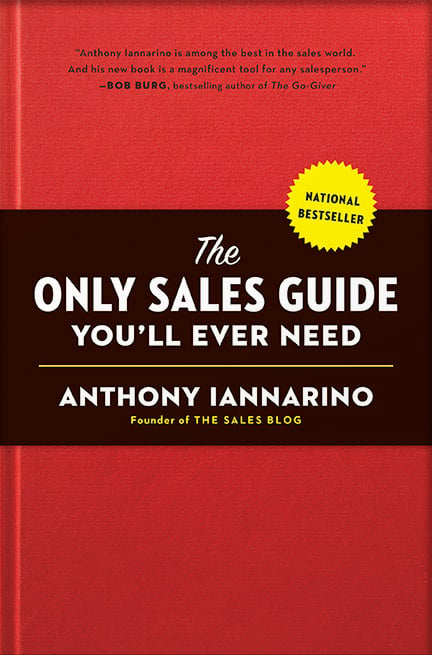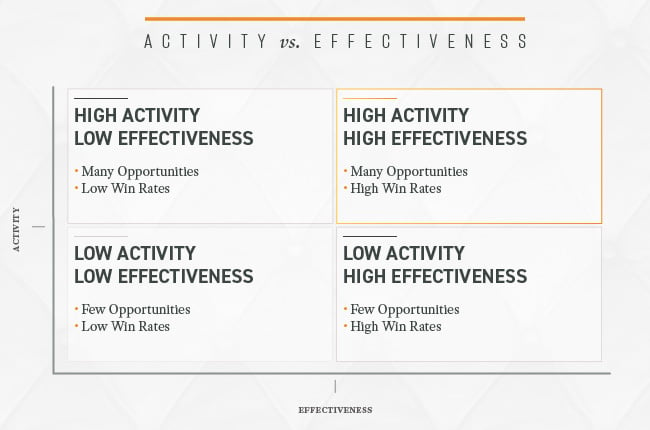The idea that “sales is a numbers game” contains an absolute truth worth observing. The truth is that selling requires action or “activity” if you prefer. All things being equal, more activity is better than little—or no—activity. But activity alone is not enough to produce success, even if one occasionally bumps into success by taking massive action.
Activity Alone
In the past, for many sales organizations, increasing sales meant increasing sales activity. Making more calls was better than making fewer. More salespeople were better than fewer salespeople, each additional sales rep expanding the amount of activity. The main idea here, something we will call “more,” led to the notion that asking more people or companies to buy (i.e., always be closing) meant increased sales.
The reason the idea of “more activity” took hold is that it worked. When sales was more transactional and less consultative, the idea of more significant activity being the primary way to increase sales worked well for many sales organizations and salespeople. If ten salespeople could sell to ten prospects and win one deal, then twenty sales reps could sell to twenty prospects and win two deals.
At a certain point, when a sales organization could add no more salespeople, ten salespeople would be required to call on twenty prospects, increasing the number of asks. To reach these numbers, the salespeople responsible for the meetings gave their companies what they asked for by calling on prospects without any regard for whether or not they were qualified or would benefit from buying what they sold.
New managers who grew up under managers who only asked for more activity followed the same thinking of those that had come before them, repeating the pattern and the mistakes. Activity is essential, but it isn’t the only important variable when it comes to success in B2B sales, especially consultative sales.
Plus Effectiveness
While sales activity is important, sales effectiveness is equally important. The idea that action alone is enough to succeed in sales is false, meaning the idea that “sales is a numbers game” is incorrect, as it eliminates the critical variable of effectiveness.
Over the decades, B2B sales have been following a path from a more transactional approach to a more consultative approach. The direction is towards more significant value creation, something qualitative, not quantitative. While activity is still important, the effectiveness of the activity is even more critical, as an activity that generates no outcomes is wasted time and effort, making one inefficient. Increasing inefficient activity isn’t the right way to improve sales results. Increasing efficiency is a better solution, even if it is more difficult to achieve.
The reason some sales leaders and managers insist on “more activity” is twofold. First, if you can’t improve a sales forces’ effectiveness, then all you have to work with is more activity. Second, a lot of salespeople would do a lot better if they did more work, especially around prospecting.
Working on Both Axes
Imagine two axes. One axis is activity; the other is effectiveness.
Low Activity – Low Effectiveness (Few Opportunities, Low Win Rates): In the bottom left corner, you have low activity and low effectiveness, resulting in poor sales results. Many small and medium-sized businesses suffer from having too little action and a lack of skills when it comes to selling effectively. Most have no sales process, no methodologies, and antiquated approaches. When this is true, it is likely they try to increase their results by increasing activity, not by standing up a real sales organization. Because the problem is found in an inadequacy on both axes, both need to improve.
Low Activity – High Effectiveness (Few Opportunities, High Win Rates): In the bottom right corner, you have low activity with high effectiveness. Many medium to large sales organizations with a B2B sales force fall into this category, with effective salespeople who do little prospecting and opportunity creation. To improve their results, these companies primarily need to focus on increasing their activity, as their effectiveness isn’t being deployed appropriately. This is a one-axis problem.
High Activity – Low Effectiveness (Many Opportunities, Low Win Rates): The top left quadrant is high activity and low effectiveness. You can work hard and still not get very much done. You can make a lot of calls, meet with a lot of prospective clients, complete a lot of RFPs, and lose a lot of deals. The results you might produce in this quadrant may be higher than the one with low activity, but creating the results you are capable of means working on one axis, your effectiveness.
High Activity – High Effectiveness (Many Opportunities, High Win Rates): The top right quadrant is both high activity and high effectiveness, marked by many opportunities and high win rates. High growth companies find a way to succeed in both axes. They increase the right activities while also focusing on the effectiveness necessary to produce the right outcomes for their company and their clients. While this approach is available to all companies, only those who prioritize sales, believing they are a sales organization first and foremost, dedicate the time and resources to work their way towards this quadrant.
The Individual Salesperson
It’s difficult not to address the individual salesperson when it comes to the idea of sales as a number game. Your effort is individual, something wholly within your control. Your effectiveness is also individual, meaning that any improvement in efficiency needs to come from you. Improving your results means working on both increased activity and increased productivity.
You are responsible for your own personal and professional development. You can make no more significant investment than the one you make in yourself.
For organizations, it’s more challenging to work on both axes. You need a sales process, methodologies around things like value creation, consensus, discovery, and resolving concerns. You also need to provide training and development, including coaching teams and individuals, to help improve their ability to take effective action.
Sales cannot be reduced to quantitative measures. It also requires as much—or more—emphasis on the more challenging qualitative factors.

Essential Reading!
Get my first book: The Only Sale Guide You'll Ever Need
"The USA Today bestseller by the star sales speaker and author of The Sales Blog that reveals how all salespeople can attain huge sales success through strategies backed by extensive research and experience."
Buy Now








.jpg?width=768&height=994&name=salescall-planner-ebook-v3-1-cover%20(1).jpg)


